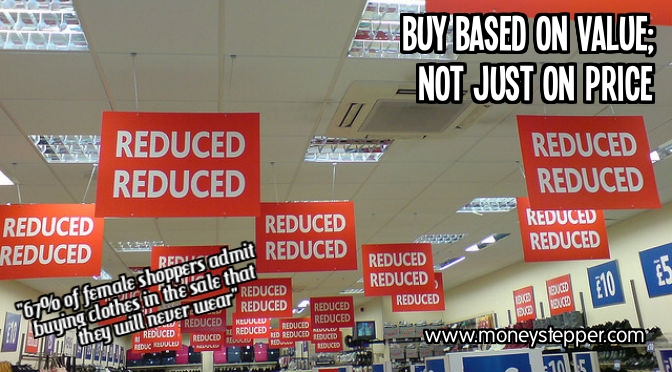Don’t just buy on price – it will end up costing you more in the long-run. Instead, buy based on value and you will be sure to get the best bang for your buck.
With the growing popularity of Poundland, Primark, Lidl, and other such retailers, it seems that the UK public are becoming increasingly focused on price. Discount retailers are outperforming their quality counterparts and this trend doesn’t seem to be ending any time soon.
Here at moneystepper, we certainly support cheaper prices and reducing our expenditure. However, are we taking it too far? Has our focus become so fixed on price that we are forgetting the more important factor of “value”.
Price vs value and false economies
Just because a product or service costs less, it doesn’t necessarily mean it will be cheaper for you in the long run.
One commonly used example of a false economy is toilet paper. The value range may cost much less, but you need to use a lot more of it to, erm… get the job done!
Think about bin bags. Maybe the value range only costs £1 for 50 bags, as opposed to £1.50. However, if the cheap bags are so flimsy that you have to use two every single time you take the bins out through fear that they will split, this clearly isn’t saving you money.
The list goes on. You can get shoes from cheap outlets for less than £10. However, if they need replacing 4 times a year, they are probably costing you more than buying a more expensive, quality pair up front.
Buy based on value – the other end of the spectrum
This unfortunately isn’t a cut and dry issue. On the other end of the spectrum, you cannot guarantee quality just because a product is more expensive. More often than not, you will be paying a premium simply for the brand name or the shop from which it is purchased.
How can you tell the difference? Research.
Go online and type the product you are buying into google. Read all the reviews. More often than not, people will rave about products which are expensive but represent good value. I recently noticed that a backpack online mentioned a lifetime guarantee. It was more expensive, but the customers on amazon and other such sites were very generous in their praise for the product. Consider it bought!!
Buying only on price, and not on need
Another worrying trend that we are seeing is that consumers are often buying goods or services based on their price, without considering whether they really need the product. Buying a skirt for £5 may be cheap, but if you never wear the skirt, its cost per use shoots up to £ infinite – pretty expensive I’m sure you’ll agree.
According to a recent stat I saw in the BA in-flight magazine: “67% of female shoppers admit buying clothes in the sales that they will never wear”. This is a frightening statistic, but the actual figure is probably even higher as I imagine that many of the people surveyed would not be happy to admit such a careless purchase!
Buy based on value – The Conclusion
Don’t let the price dictate the purchase. Every single purchase of goods or services should be approached using the same two-step approach:
- Determine the need for the item
- Compare a range of options and buy based on value (determined using both the price and the quality of the product in question)
If you enjoyed this article, I would be very grateful if you would share via social media:
[cunjo layout=”inline_buttons”]

My rule of thumb is that I will give the cheapest product a try or two, to see if it meets my expectations. In most cases this has been positive, but there are indeed certain things where I rather pay a bit more.
A good example of this recently was kitty litter. I figured I’d buy the bio-degradable kind from the supermarket rather than the one from the pet store. It would save me 50 cents a bag, both equal in weight. However it was such poor quality that it started to smell after only a day or two and my cat was so upset with it that he peed on the sofa. Ended up having to purchase enzyme cleaner for the sofa, so it was indeed more expensive. Back to the old litter I went. That stays fine a whole week provided daily scooping, and my cat uses the box properly every time again.
this is an important aspect of managing finances and cutting the fat out of budget. Often we feel the urge of buying things when we see discounts and coupons. that’s actually money spent on “not needed” items, not a saving at all.
There are some things that I really won’t won’t skimp on – toilet paper, coffee, camping gear. I try to buy these items on sale and only when I really need them, but I’ve found out the hard way that there are some things you just have to pay more for. On the other hand, I buy a lot of generic food because I can’t tell the difference and so the value is the same for a lower price.
We often do a test purchase–we’ll buy the cheapest of an item (say toilet paper) and test it out. If it doesn’t perform well, we’ll buy the slightly more expensive version the next time we need it. This system works pretty well for us and lets us feel confident that we are indeed buying the cheapest we can, while still reaping value.